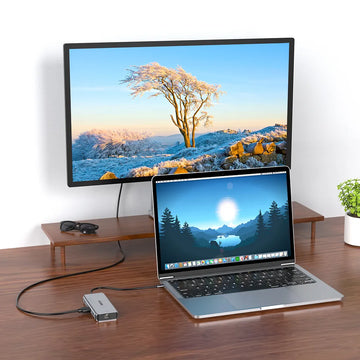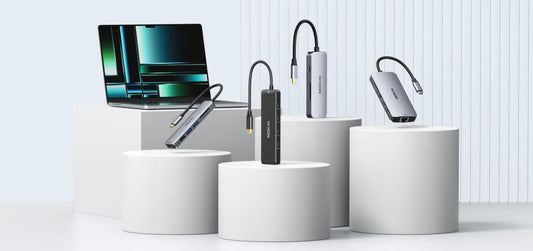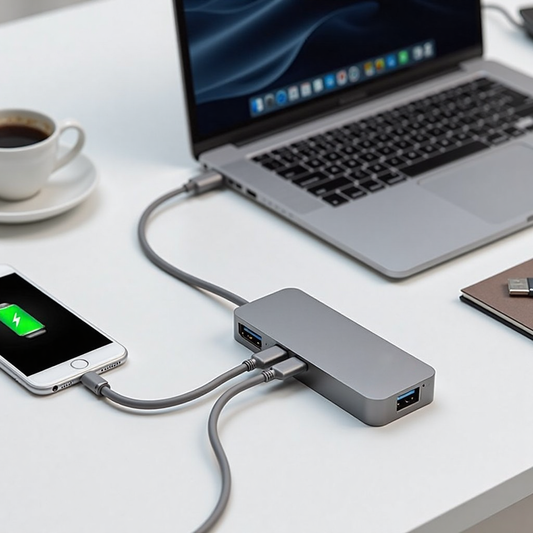Importance of Ethernet Adapters in Windows 11
——————————
Ethernet adapters play a crucial role in increasing network connectivity options for various devices without built-in RJ45 ports. USB C Ethernet adapters are typically plug-and-play devices and work with a wide range of devices running Windows 11, offering versatility and flexibility.
Ethernet hubs or docks provide a reliable network for modern laptops with limited connectivity options. Ethernet connections typically offer faster speeds compared to Wi-Fi, making them ideal for tasks that require high bandwidth, such as online gaming, video streaming, and large files transmission.

For business meetings, a wired connection provided by an Ethernet dock is able to ensure an uninterrupted connection, preventing potential disruptions during important calls. Therefore, USB C Ethernet docks are a preferred choice for situations where data security are priorities.
However, some users need help with the Ethernet port on the dock not being recognized in Windows 11. Take an example: one of the users reflects, “I have a USB C 16 in 1 hub with an Ethernet that does not work in Windows 11 when all other ports work fine. I installed the last drivers for Windows 11, and it still does not work. I have Asus Vivobook with Amd Ryzen 7 3700U with Realtek 8822CE Wireless Lan - wireless works at 400 Mbit/s. I also have a VPN connection with ExpressVPN. I intend to use an Ethernet connection via USB C hub because it is faster than wireless; this connection is 1000Mbit/s, and my internet connection is 1000 Mbit/s so that I can use my internet at maximum speed. Do you have any solution?"

Another user said, “My Ethernet adapter isn't working - In Device Manager, under Universal Serial Bus controllers, the adapter for the device that is not working appears as ‘Unknown USB Device or Device Descriptor request failed.’ I have tried everything from updating all the drivers, doing Windows updates, and doing a few things on the command prompt, all from the internet, and I am going mad. However, some of these fixes do contain a Generic USB hub under the Universal serial bus controllers section, and I don't have it. That may be the cause of my issue, but regardless of whether it is linked to that or not, I would really like help to solve this issue as a whole. It was working yesterday and now today it isn't. I would very much appreciate the help; thank you in advance.”
Utilize the Ethernet connection through the USB C hub for faster speeds, running at 1000Mbps. This article aims to provide tips for resolving issues of the RJ45 port on your hub not working.
Identify The Issues
——————————
If the Ethernet port is not recognized by your PC, it may appear as an unknown device or with an error indicator. Open Device Manager by right-clicking on the Start button and selecting it. Look for any unknown devices, devices with a yellow exclamation mark, or devices labeled as “Ethernet Controller” or similar.
Check the LED indicators on the dock. The LED indicators should show activity when a network cable is connected. If it is not recognized, the LED indicators may remain inactive.
You may not see any Ethernet connection listed if the Ethernet recognition fails. Right-click on the network icon in the taskbar and select “Open Network & Internet settings.” And click on “Change adapter options” to view the network connections.
Errors or warnings indicating issues with the Ethernet port can help identify recognition problems. Open “Event Viewer” by searching for it in the Start menu. Look for any error or messages related to the Ethernet adapter or the dock under the “Windows Logs” section.
If the Ethernet port is not recognized, it may not appear in the list of network connections. You may not find the docking station in the network connection settings, or the adapter may be marked as disabled. Or it may cause errors in system or network settings, such as incorrect IP configuration. Go to “Settings” and find “Network & Internet.” Check if the Ethernet connection is listed under “Ethernet” or “Change adapter options.”
Common Causes
——————————
● Hardware Problems:
The hub itself may be defective. Testing the devices on another computer.
Loose or faulty connections between the USB hub and the computer can lead to the Ethernet port not working. Check the physical connections and try reconnecting them securely.
● Driver Issues:
Incompatible drivers for the docking station and Windows 11 are able to prevent proper functionality. Ensure that the correct drivers are installed and up to date.
● Compatibility Problems:
The Ethernet dock might require full compatibility with Windows 11. Ensure to look for driver updates or firmware enhancements that solve any compatibility issues.
● Power Management Settings:
Power-saving settings in Windows may turn off the Ethernet adapter to save power. Turn off the option that allows the computer to turn off the device to save power in the device’s properties. Some security software or firewall settings may block the Ethernet connection, causing it not to work. Temporarily turning off security software for testing purposes can help identify.
● Network Configuration Issues:
Incorrect network settings or configurations in Windows 11 can cause the Ethernet port on the USB hub to not function properly.
● Ethernet Adapter Settings:
Incorrect configurations of the network adapter or conflicts with other network devices may lead to the Ethernet port on the USB hub stopping to function.
● System Errors:
Errors within the Windows 11 system occasionally impact the normal operation of hardware devices. Utilizing system troubleshooting tools can assist in addressing these issues.
Solutions
——————————
● Check Firmware
Examine the Ethernet port and cable for signs of damage. Try connecting the dock to a different PC to determine if the USB C port on your device is faulty.
If there is a problem with the Ethernet port on your dock, it could be hindering the connection. Remove the network cable from the current Ethernet port and insert it into another port for testing.
● Update Drivers
Check for Ethernet driver updates manually. The existing driver might be corrupted or outdated, and that could be causing the network problem.
Locate the unknown device in “Device Manager,” right-click and select “Update Driver.” Download the latest driver from the manufacturer's official website or run a driver update tool to make it.
● Uninstall the Drivers
Uninstall the driver from Device Manager. Once finished, restart your computer. Windows will automatically detect connected devices and install the needed driver for the Ethernet dock.
● Adjust System Settings
Windows 11 is set to automatically turn off the Ethernet connection to conserve power when there is no activity for a specific period. To maintain a steady Ethernet connection, you can prevent this behavior by accessing “Device Manager.”
Find Device Manager and launch it. Search the Network adapters section, right-click on the Ethernet adapter, access its Properties, navigate to the Power Management tab, disable the computer to power off this device for power conservation, and save the change by clicking “OK.”
Conclusion
——————————
For most cases, simply unplugging and re-plugging cables, performing a power reset, and resetting the Windows network settings can resolve the issue.
Avoid frequent plugging and unplugging of USB devices to prevent damage to the port. Pay attention to the settings of security software and firewalls to avoid blocking the device connection by mistake.
We recommend MOKiN USB C Docking Stations for Ethernet for your reference.
YOU MAY ALSO LIKE
——————————
USB C to HDMI Hubs Not Working -- How to Fix?
How to Record iPhone Video to the Hard Drive Using A USB C Hub



















